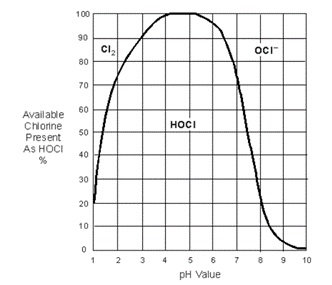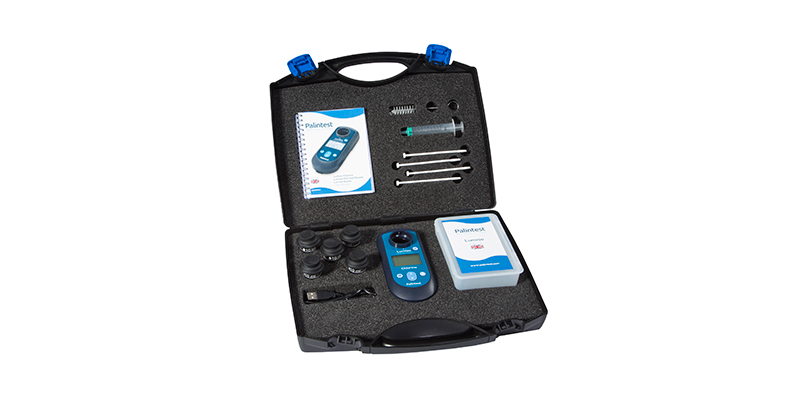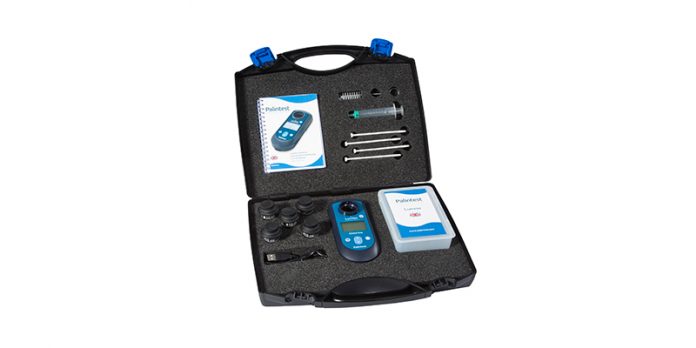The disinfection of drinking water with chlorine must be at levels high enough level to kill any harmful pathogens present, but not too high where it could cause adverse health effects if consumed. Water must then be monitored during and after treatment to validate the effectiveness of the disinfection processes and ensure the water is safe to consume.
Legal standards are set to define what is considered ‘safe’ drinking water. The Guidelines for Drinking Water Quality set out by the World Health Organisation are global guidelines which are used to inform the national standards set. For chlorine in drinking water, the WHO has a health-based guideline of 5 mg/L maximum. In England and Wales, water quality is regulated by the Drinking Water Inspectorate, and in the US standards are set by the US EPA. The DWI follow the WHO advice, whereas the US EPA states the maximum residual disinfectant level for chlorine in drinking water is 4.0 mg/L.
In water, chlorine exists as either hypochlorous acid (HOCl) or hypochlorite ions (OCl–). Both of these forms of chlorine are known as ‘free chlorine’. The relative amount of these forms of free chlorine is dependent on the pH of the water, as shown in the graph below. At higher pH values, there will be a larger proportion of the chlorine present as hypochlorite. At very low pH values, most of the chlorine will be present as hypochlorous acid or chlorine gas.

Free chlorine has strong oxidising characteristics, meaning it can destroy or inactivate harmful pathogens in water by breaking down bacterial cell membranes, enzymes, and proteins. It is important to maintain a controlled residual of free chlorine to ensure the water supply remains free from pathogens.
As a general rule, when treating water with chlorine for disinfection, the chlorine should be maintained as hypochlorous acid, so monitoring the pH of the water is important. If the water quality is poor, higher levels of chlorine may need to be added to give a high enough residual of free chlorine for effective disinfection.
As chlorine is a reactive species, it often reacts with other elements and compounds present in the water sample, reducing the amount of free chlorine available for disinfection. When chlorine reacts with organic nitrogen compounds, combined chlorine species are formed. Combined chlorine species are less effective disinfectants than free chlorine, but they tend to persist for longer in the water. A free or combined chlorine residual of 0.5–1 mg/L should be enough to maintain the quality of the water throughout the distribution network.
Monitoring Chlorine in Drinking Water
One of the most popular methods for chlorine analysis in drinking water is photometry. Most water companies aim to keep the chlorine level in drinking water below 1 mg/L, however monitoring requirements may be higher than this during pipework maintenance or depending on the stage of the treatment process.
The Lumiso Chlorine photometer can measure free and total chlorine in our standard range (0.01–5 mg/L) or extended range (1–250 mg/L), making it perfect for testing routine chlorine disinfection levels or higher levels where required.
Traceable and Auditable Data Set
Lumiso Chlorine can store up to 50 data sets on the instrument’s memory, and it has a live clock meaning the exact date and time is saved for each measurement. This allows for full traceability for compliance and auditing purposes.
To assist with auditing and data management, the instrument has USB connectivity or the option to generate a QR code containing the data log, allowing data to be transferred from the instrument to another device to record or share when required. The USB connectivity also enables software updates to be applied in-field, rather than having to return the instrument to Palintest, allowing the instrument to remain in the field without downtime for longer.
Repeatable and Reliable Results with Minimum Maintenance
The optical platform of the new Lumiso instruments has been designed with photometer performance and ease-of-use in mind. The instrument calibrations are certifiable to National Institute of Standards and Technology (NIST) traceable spectrophotometers, enhancing measurement performance and accuracy between Lumiso instruments.
In addition, the optical chamber of the new Lumiso is streamlined, removing dirt traps and tough-to-clean areas so the optics are easy to clean. This saves time on instrument maintenance and ensures performance accuracy is maintained.
Extended Battery Life for Less Downtime Between Testing
Lumiso Chlorine can perform at least 20,000 tests on a single set of batteries, even with the backlight turned on. As the instrument has been designed to be more energy efficient, the power consumption is lower and therefore it is likely to run for even longer than this. This allows the instrument to be used on site or in the field for extended periods without losing power.
Palintest’s New Lumiso Chlorine Photometer Kit

The Lumiso Chlorine Kit has been designed to be used without extensive training, and includes features which make in-field testing as easy as possible. The new Lumiso Chlorine kit includes:
- A lightweight, handheld instrument which can be used to measure standard and extended range free and total chlorine.
- A reusable reagent box to store any reagents purchased with the kit.
- Easy-to-follow pictorial instructions to ensure instrument set up and use is simple and straightforward.
- Individual slots for accessories, and spaces to store the NDF Check Standards, ensuring everything you need for testing and instrument maintenance is contained within one case.
- A hard case so all the equipment can be easily stored and protected during transport.
To learn how you could benefit from an easy-to-use, accurate and auditable method of monitoring chlorine in drinking water, please contact a member of our team by clicking here.



